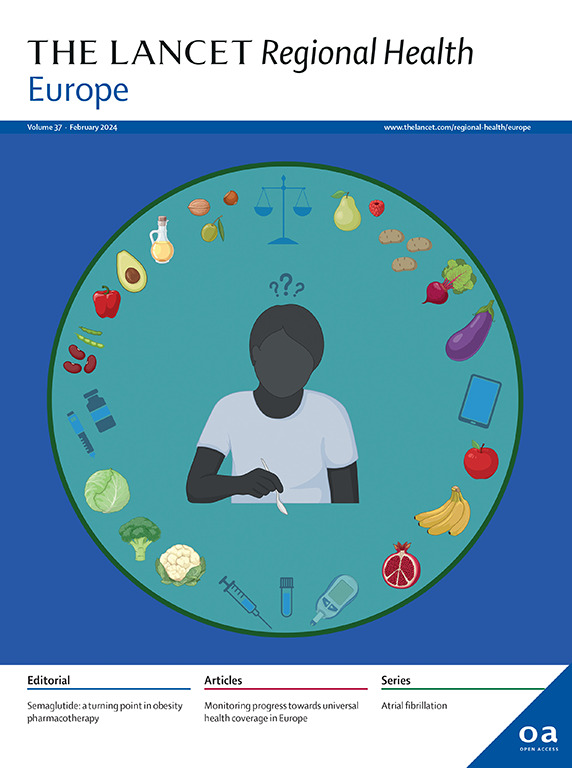Evaluation of a national digital pre-implantation biopsy service for deceased-donor kidney transplantation in the UK (Pithia trial); a stepped-wedge cluster randomised registry trial
IF 13
Q1 HEALTH CARE SCIENCES & SERVICES
引用次数: 0
Abstract
Background
Pre-implantation biopsy may help select kidneys retrieved from elderly deceased donors for transplantation, but concerns persist that it may cause unnecessary discard of kidneys that would have provided acceptable transplant function. The PITHIA trial tested the hypothesis that introduction of a National Digital Pathology Service (NDPS) would increase the proportion of kidneys transplanted from elderly donors and/or improve their function.
Methods
A stepped-wedge cluster randomised controlled registry trial delivered the NDPS to 22 UK kidney transplant centres (clusters) in 5 sequences at four-monthly intervals, using a restricted randomisation technique to ensure similar cluster sizes in the intervention and control status. Upon access to the intervention, centres could request urgent pre-implantation biopsy on kidneys from deceased donors aged 60 years or older. Co-primary outcome measures were the proportion of kidneys transplanted upon first offer according to whether the centre had access or not to the biopsy service, and the 1-year eGFR of the kidneys that were transplanted. Analysis adjusts for clustering and underlying secular trends, with 97.5% Confidence Intervals (CI) reported to reflect the two co-primary outcomes. The trial is complete (Trial Registration Number: ISRCTN 11708741).
Findings
The trial commenced on 1st October 2018 and ended on 31st January 2022. Of the 2502 eligible kidneys offered, 1355 single and 67 dual transplants were performed. Regarding the first primary endpoint, a non-significantly lower proportion of those kidneys first offered to centres with access to the biopsy service were transplanted compared with those offered to centres without access (295 of 1241 (23.8%) vs. 377 of 1261 (29.9%): adjusted Odds Ratio (97.5% CI) 0.91 (0.60–1.39); p = 0.6083). For the second primary endpoint, the adjusted mean (SE) 1-year eGFR of the transplant kidneys was similar, irrespective of whether the implanting centre had access to the biopsy service or not (43.7 (1.3) ml/min/1.73 m2 vs. 42.2 (1.3) ml/min/1.73 m2; adjusted mean difference (97.5% CI) 1.53 (−2.33 to 5.40); p = 0.37). Secondary outcome analysis of how the biopsy service was adopted revealed that biopsies were performed on 287 of the 1493 (19.2%) kidneys offered to at least one centre with access to the biopsy service, with marked variation between transplant centres in requests for biopsy, and in implantation rates of biopsied kidneys. Nevertheless, 191 (66.6%) of biopsied kidneys were transplanted, compared with 643 of the 1009 (63.7%) kidneys only ever offered to centres without biopsy access, and 588 of the 1206 (48.8%) kidneys that were not biopsied, despite being offered to at least one centre with biopsy access.
Interpretation
Implementation of the NDPS did not significantly increase transplantation rates of elderly deceased donor kidneys upon first offer, nor improve 1-year eGFR of the transplanted kidneys. This may reflect inter-centre variation in adoption and application of the biopsy service; such variations would need to be considered when designing future studies of pre-implantation biopsy analysis.
Funding
NIHR Research for Patient Benefit programme (RfPB PB-PG-1215-20033).
评估英国死亡供体肾移植的国家数字化植入前活检服务(Pithia试验);一项楔步聚类随机注册试验
背景:植入前活检可能有助于选择从老年已故供体中取出的肾脏进行移植,但担心它可能导致不必要的丢弃,而肾脏本可以提供可接受的移植功能。PITHIA试验测试了一个假设,即引入国家数字病理服务(NDPS)将增加老年捐赠者肾脏移植的比例和/或改善其功能。方法一项楔形聚类随机对照注册试验,采用限制随机化技术,以确保干预和对照状态下聚类大小相似,以5个序列,每隔4个月向22个英国肾移植中心(聚类)提供NDPS。在获得干预后,中心可以要求对60岁或以上的已故捐赠者的肾脏进行紧急植入前活检。共同主要结局指标是根据中心是否有机会获得活检服务,第一次提供肾脏移植的比例,以及移植肾脏的1年eGFR。分析调整了聚类和潜在的长期趋势,报告了97.5%的置信区间(CI)来反映两个共同的主要结果。试验完成(试验注册号:ISRCTN 11708741)。该试验于2018年10月1日开始,于2022年1月31日结束。在2502个符合条件的肾脏中,1355个进行了单次移植,67个进行了双次移植。关于第一个主要终点,与提供给无法获得活检服务的中心的肾脏相比,首次提供给可获得活检服务的中心的肾脏移植比例不显著降低(1241例中有295例(23.8%)对1261例中有377例(29.9%):调整优势比(97.5% CI) 0.91 (0.60-1.39);P = 0.6083)。对于第二个主要终点,无论移植中心是否有活检服务,移植肾脏1年eGFR的调整后平均(SE)是相似的(43.7 (1.3)ml/min/1.73 m2 vs. 42.2 (1.3) ml/min/1.73 m2;校正平均差(97.5% CI) 1.53 (- 2.33 ~ 5.40);P = 0.37)。对活检服务采用情况的二次结果分析显示,1493个肾脏中有287个(19.2%)接受了活检,至少有一个中心提供了活检服务,移植中心之间在活检请求和活检肾脏植入率方面存在显著差异。尽管如此,191个(66.6%)活检肾脏被移植,相比之下,1009个肾脏中有643个(63.7%)只提供给了没有活检通道的中心,1206个肾脏中有588个(48.8%)没有活检,尽管至少提供给了一个有活检通道的中心。NDPS的实施并没有显著提高老年已故供体肾脏的首次移植率,也没有改善移植肾脏的1年eGFR。这可能反映了各中心在采用和应用活检服务方面的差异;在设计植入前活检分析的未来研究时,需要考虑这些变化。资助美国国立卫生研究院患者福利研究项目(RfPB PB-PG-1215-20033)。
本文章由计算机程序翻译,如有差异,请以英文原文为准。
求助全文
约1分钟内获得全文
求助全文
来源期刊

Lancet Regional Health-Europe
Multiple-
CiteScore
19.90
自引率
1.40%
发文量
260
审稿时长
9 weeks
期刊介绍:
The Lancet Regional Health – Europe, a gold open access journal, is part of The Lancet's global effort to promote healthcare quality and accessibility worldwide. It focuses on advancing clinical practice and health policy in the European region to enhance health outcomes. The journal publishes high-quality original research advocating changes in clinical practice and health policy. It also includes reviews, commentaries, and opinion pieces on regional health topics, such as infection and disease prevention, healthy aging, and reducing health disparities.
 求助内容:
求助内容: 应助结果提醒方式:
应助结果提醒方式:


